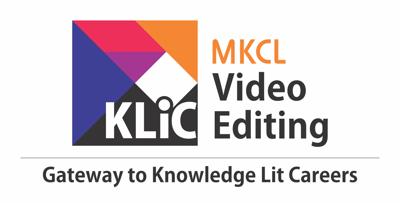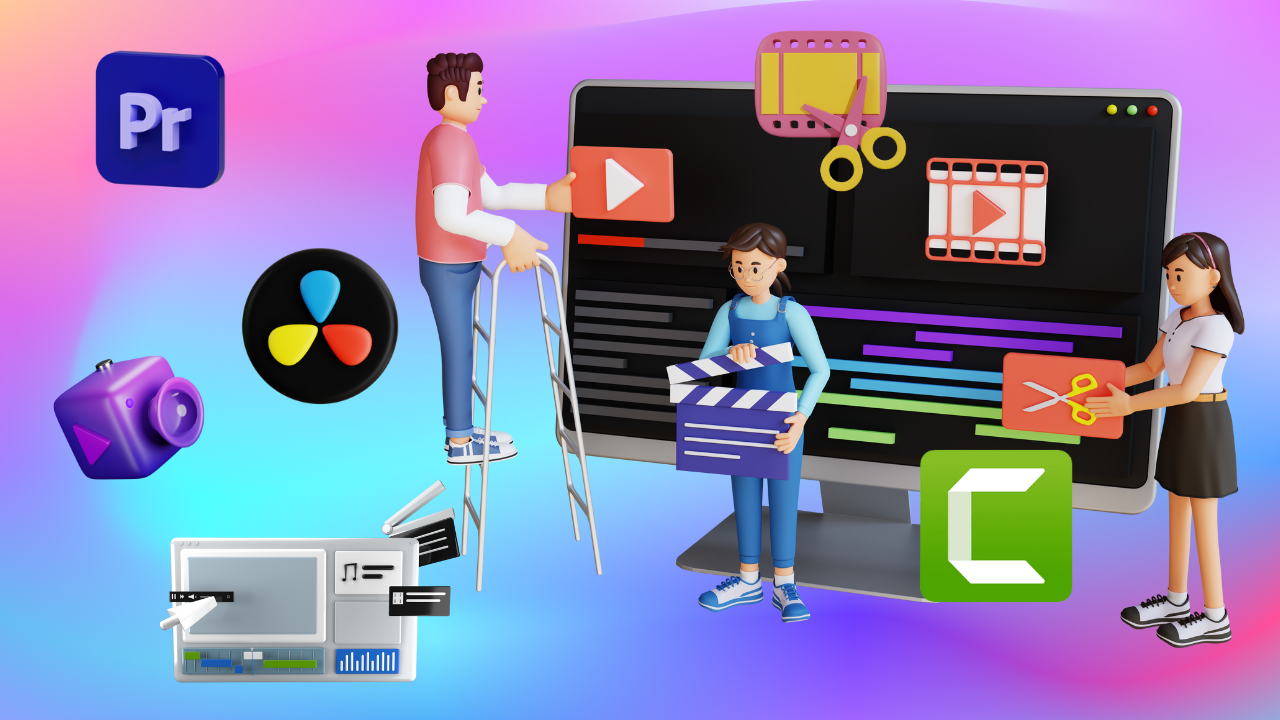- In this course, you will learn to:
- Identify the importance of creative elements in video editing and their role in enhancing video quality
- Illustrate the application of titles, graphics, and lower thirds in creating engaging videos
- Interpret color theory concepts and their impact on video design and visual storytelling
- Construct animated elements such as kinetic text and motion graphics for creative video presentations
- Develop skills in special effects and compositing to enhance visual elements in videos
- Explain the fundamentals of color grading, including color schemes, corrections, and advanced grading techniques
- Analyze the use of motion tracking and picture-in-picture effects in professional video projects
- Solve challenges in green screen compositing using advanced techniques for seamless integration
- Design creative transitions and blend modes to enhance video montages and storytelling
- Appraise ethical considerations, project organization, and technical setups for efficient video editing workflows
- Explore the integration of artificial intelligence tools to streamline video editing tasks and enhance creativity
- Create and edit virtual reality content using advanced VR tools and templates

Creative Elements in Video Editing
Integrate audio, effects, motion graphics, and pacing to elevate video storytelling creatively.
Introduction
What you'll learn ?
- At the end of this course, learners will be able to:
- Interpret the significance of creative elements in video editing to improve viewer engagement
- Illustrate captivating titles, lower thirds, and graphics for professional video projects
- Compare different compositing techniques to create visually appealing effects in videos
- Develop advanced animated elements such as shapes, icons, and kinetic text for motion graphics
- Predict the outcome of applying various color grading techniques to achieve desired visual effects
- Combine motion tracking and rotoscoping to produce seamless video edits
- Assess the effectiveness of green screen compositing in integrating visual elements into a video
- Construct compelling video montages using techniques such as metric, rhythmic, and tonal montages
- Design efficient workflows using ethical practices, project settings, and organizational tools
- Modify video edits with AI tools like auto-generated storyboards, speech-to-text, and scene detection for greater efficiency
- Prepare and export VR footage with appropriate effects and animated graphics for immersive experiences
- Review plugins like Red Giant Magic Bullet and Motion Bro to enhance video quality and transitions
- Create unique effects and transitions using custom templates, presets, and plugins for advanced video editing
- Introduction to Creative Elements in Video Editing
- Importance of Creative Elements in Video Editing
- The Role of Graphics in Video Editing
- The Importance of Titles in Videos
- Designing Captivating Titles for Videos
- Color Theory in Titles
- Animation and Motion in Titles
- Mastering Lower Thirds in Video Editing
- Analyzing Lower Thirds in Popular Videos
- Special Effects and Compositing
- Interface and Project Setting
- Editing Lineup
- Text Composition
- Basic - Transitions and Masking
- Text-Based Editing and Transcribe
- Sound effects (SFX)
- Case study - Basic Compositing
- Case study - Compositing text animation
- Animated elements for creativity
- Creating Shapes and Nest
- Shape Animation / Temporal Interpolation
- Track Matte Key / Text Animation
- Kinetic Text Animation
- Motion Graphics - Spatial Interpolation
- Motion Graphics - Icons and Assets
- Case study - Creating shape for lower third
- Case study - Animating shape for lower third
- Fundamentals of Color Grading
- Overview and coloring effects
- Analyzing clip for color correction
- Color Scheme
- Color Theory
- Color Replacement
- Video Limiter
- Visual Filters and Lumetri Scope
- Lumetri Color Space
- Lumetri Color - Color Control
- Lumetri Color - HSL
- Lumetri Color - Advance Color Grading
- Filters and Presets
- Case study - Visual Filters
- Case study - Lumetri Scope
- Motion Tracking and Picture in Picture Effects
- Overview of Motion Tracking
- Manual Motion Tracking
- Picture in Picture
- Automatic Motion Tracking
- Advance Motion Tracking
- Rotoscoping with Motion Tracking
- Adding Text with Rotoscoping
- Working on your own footage - Motion Tracking
- Green Screen Compositing
- Compositing - Overview
- Compositing Ultra Key
- Screen replacement - Nest
- Screen replacement - Corner pin
- Advance Compositing
- Advance green screen techniques
- Case study - green screen compositing
- Case study - Compositing Matching with background
- Time Remapping
- Time Remapping Overview
- Tools for Time Remapping
- Slow Down
- Speed Up
- Reverse
- Freeze Frames
- Image sequence for time-lapse
- Nesting sequence for time-lapse
- Time adjustment with Curves
- Time Interpolation
- Case study - Time Remapping
- Blend modes and transitions
- Blend Mode Overview and Subtractive Blend
- Additive Blend Modes
- Complex, Difference and HSL
- Blend Mode as effects
- Transitions Overview
- Blend Mode as Transition
- Advanced Transition
- Video Montages
- Montage Overview
- Metric Montage
- Stabilizing your Footage
- Rhythmic Montage
- Tonal Montage
- Overtonal Montage
- Intellectual Montage
- Ethical Considerations and Experimentation
- Naming convention
- Folder Arrangements and Project Settings
- Importing projects and sequences
- Codec and Format
- Ingest and Proxies
- Rendering and FTP
- HDR and SDR in Video Editing
- Offline Clips and Dynamic Linking
- Meta Data
- Program Monitor Button Editor
- Alignment with Program Monitor Buttons
- Media Cache
- Project Manager
- Integrating Artificial Intelligence
- Premiere with AI
- Auto-Generated Storyboards
- Text Based Editing
- Speech to Text
- Text Effects
- Enhance Speech
- Adobe Podcast
- Image Generation
- Scene Edit Detection
- Morph Cut Transitions / Auto Log
- Audio Remix
- Exploring Advanced AI Features
- Virtual Reality
- Overview Virtual Reality
- VR Project Setup
- Importing VR footage
- Editing VR Footage
- Applying VR Effects
- Testing and Previewing
- Titles in VR Workspace
- Animated graphics in VR
- VR Export
- VR Templates and Assets
- Plugins and Presets
- Red Giant Magic Bullet overview
- Using Motion Bro Plugin
- Using Neat Video Plugin to Denoise Video
- Customizing Design Layout with Motion Bro plugin
- Using Mr. Horse Premiere Composer
- Text Effects Templates Using MOGRT Graphics
- Using Continuum Film Looks and Grain
- Using Continuum Transitions
- Using Film Impact Plugins
- Using Magic Bullet Effects to Color Grade
- Using the Essential Motion 2.0 Plugin
Certification
- KLiC courses are recognised by Yashwantrao Chavan Maharashtra Open University (YCMOU).
- MKCL provides certificate to the KLiC learner after his/her successful course completion.
- Yashwantrao Chavan Maharashtra Open University (YCMOU) provides mark sheet to successfully passed KLiC learners (Jurisdiction: Maharashtra).
Academic Approach
The academic approach of the courses focuses on the “work-centric” education i.e. begin with work (and not from a book!), derive knowledge from work and apply that knowledge to make the work more wholesome, useful and delightful. The ultimate objective is to empower the Learner to engage in socially useful and productive work. It aims at leading the learner to his/her rewarding career as an employee or entrepreneur as well as development of the community to which s/he belongs. Learning methodology:
- Step -1: Learners are given an overview of the course and its connection to life and work.
- Step -2: Learners are exposed to the specific tool(s) used in the course through the various real-life applications of the tool(s).
- Step -3: Learners are acquainted with the careers and the hierarchy of roles they can perform at workplaces after attaining increasing levels of mastery over the tool(s).
- Step -4: Learners are acquainted with the architecture of the tool or tool map so as to appreciate various parts of the tool, their functions, utility and inter-relations.
- Step -5: Learners are exposed to simple application development methodology by using the tool at the beginner’s level.
- Step -6: Learners perform the differential skills related to the use of the tool to improve the given ready-made industry-standard outputs.
- Step -7: Learners are engaged in appreciation of real-life case studies developed by the experts.
- Step -8: Learners are encouraged to proceed from appreciation to imitation of the experts.
- Step -9: After the imitation experience, they are required to improve the expert’s outputs so that they proceed from mere imitation to emulation.
- Step-10: Emulation is taken a level further from working with differential skills towards the visualization and creation of a complete output according to the requirements provided. (Long Assignments)
- Step-11: Understanding the requirements, communicating one’s own thoughts and presenting are important skills required in facing an interview for securing a work order/job. For instilling these skills, learners are presented with various subject-specific technical as well as HR-oriented questions and encouraged to answer them.
- Step-12: Finally, they develop the integral skills involving optimal methods and best practices to produce useful outputs right from scratch, publish them in their ePortfolio and thereby proceed from emulation to self-expression, from self-expression to self-confidence and from self-confidence to self-reliance and self-esteem!
Syllabus
Evaluation Pattern
Evaluation Pattern of KLiC Courses consists of 4 Sections as per below table:
| Section No. | Section Name | Total Marks | Minimum Passing Marks |
|---|---|---|---|
| 1 | Learning Progression | 25 | 10 |
| 2 | Internal Assessment | 25 | 10 |
| 3 | Final Online Examination | 50 | 20 |
| Total | 100 | 40 | |
| 4 | SUPWs (Socially Useful and Productive Work in form of Assignments) | 5 Assignments | 2 Assignments to be Completed & Uploaded |
YCMOU Mark Sheet
Printed Mark Sheet will be issued by YCMOU on successful completion of Section 1, Section 2 and Section 3 and will be delivered to the learner by MKCL.
YCMOU Mark Sheet will be available only for Maharashtra jurisdiction learners
MKCL's KLiC Certificate
The certificate will be provided to the learner who will satisfy the below criteria:
- Learners who have successfully completed above mentioned 3 Sections i.e. Section 1, Section 2 and Section 3
- Additionally, learner should have completed Section 4 (i.e. Section 4 will comprise of SUPWs i.e. Socially Useful and Productive Work in form of Assignments)
- Learner has to complete and upload minimum 2 out of 5 Assignments
Courses Fee Structure from 01 July, 2025 Onwards
KLiC 30 hour course fee applicable from 01 July, 2025 all over Maharashtra
| KLiC Course Duration | MFO (Inclusive of GST) |
ALC Share (Service Charges to be collected by ALC) |
|---|---|---|
| 30 hours | Rs. 300/- | Rs. 1,500/- |
* Above mentioned fee is applicable for all Modes of KLiC Courses offered at Authorised Learning Center (ALC) and at Satellite Center
* Total fee is including of Course fees, Examination fees and Certification fees
* MKCL reserves the right to modify the Fee anytime without any prior notice
